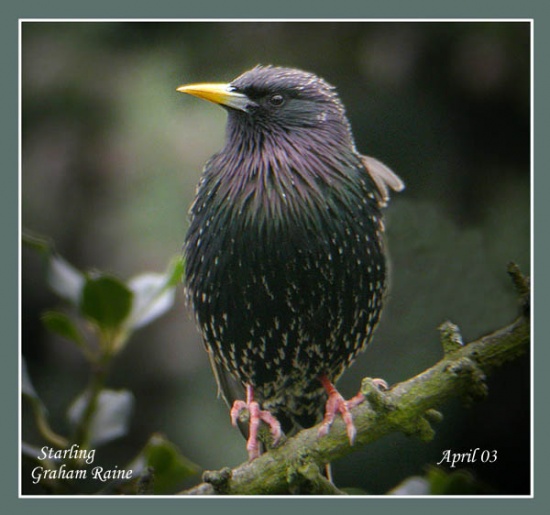(Video linked. Juvenile & Flight photos and some more information added) |
|||
| Line 2: | Line 2: | ||
[[Image:Common_Starling.jpg|thumb|550px|right|Photo by {{user|Ragna|Ragna}}]] | [[Image:Common_Starling.jpg|thumb|550px|right|Photo by {{user|Ragna|Ragna}}]] | ||
;[[:Category:Sturnus|Sturnus]] vulgaris | ;[[:Category:Sturnus|Sturnus]] vulgaris | ||
| − | |||
==Identification== | ==Identification== | ||
L. 20-22cm | L. 20-22cm | ||
| Line 13: | Line 12: | ||
With wear, the white spots are lost, while the bill and legs turn yellow. | With wear, the white spots are lost, while the bill and legs turn yellow. | ||
====Breeding==== | ====Breeding==== | ||
| + | [[Image:StarlingJ021208a.jpg|thumb|350px|right|Photo by {{user|Rookery|Rookery}}<br />Juvenile<br /> | ||
| + | Havelock North [[New Zealand]], December 2008 ]] | ||
*Adults glossy-black without any spots | *Adults glossy-black without any spots | ||
*Young birds are dull grey-brown | *Young birds are dull grey-brown | ||
| − | |||
==Distribution== | ==Distribution== | ||
This starling is native to most of [[Eurasia]], but has been introduced to [[South Africa]], [[North America]], [[Australia]] and [[New Zealand]]. | This starling is native to most of [[Eurasia]], but has been introduced to [[South Africa]], [[North America]], [[Australia]] and [[New Zealand]]. | ||
==Taxonomy== | ==Taxonomy== | ||
Polytypic. Consists of twelve subspecies. | Polytypic. Consists of twelve subspecies. | ||
| − | |||
==Habitat== | ==Habitat== | ||
| + | [[Image:Starling13.jpg|thumb|350px|right|Photo by {{user|targetman|targetman}}<br />Worlaby, [[Lincolnshire]], October 2007]] | ||
Varied. Can be found in any reasonably open environment from farmland to salt marsh. | Varied. Can be found in any reasonably open environment from farmland to salt marsh. | ||
==Behaviour== | ==Behaviour== | ||
Starlings walk rather than hop. Their flight is quite strong and direct; they look triangular-winged and short-tailed in flight. | Starlings walk rather than hop. Their flight is quite strong and direct; they look triangular-winged and short-tailed in flight. | ||
| + | |||
| + | Very gregarious out of the breeding season. | ||
| + | ====Breeding==== | ||
| + | Nests in thatches, nest boxes, tree holes. | ||
| + | ====Diet==== | ||
| + | They mainly feed on insect larvae but are opportunist feeders and will visit bird tables. They also like autum berries. | ||
====Vocalisation==== | ====Vocalisation==== | ||
<flashmp3>Sturnus vulgaris (song).mp3</flashmp3><br /> | <flashmp3>Sturnus vulgaris (song).mp3</flashmp3><br /> | ||
''[[Media:Sturnus vulgaris (song).mp3|Listen in an external program]]'' | ''[[Media:Sturnus vulgaris (song).mp3|Listen in an external program]]'' | ||
| − | |||
==External Links== | ==External Links== | ||
{{GSearch|Sturnus+vulgaris}} | {{GSearch|Sturnus+vulgaris}} | ||
| + | <br /> | ||
| + | {{Video|Common_Starling}} | ||
<br /> | <br /> | ||
'''For videos of Starling Roosts''' | '''For videos of Starling Roosts''' | ||
{{Video|Starling_roost}} | {{Video|Starling_roost}} | ||
[[Category:Birds]][[Category:Sturnus]][[Category:Videos]][[Category:Bird Songs]] | [[Category:Birds]][[Category:Sturnus]][[Category:Videos]][[Category:Bird Songs]] | ||
Revision as of 18:17, 11 April 2009
Alternative name: European Starling

- Sturnus vulgaris
Identification
L. 20-22cm Wide variation in plumage. Both sexes are similar, although the female is less glossy than the male
Non-breeding
- Glossed black with a purple and green shine
- Tips of the body feathers have large white spots
- Dark bill
- Brown legs
With wear, the white spots are lost, while the bill and legs turn yellow.
Breeding
- Adults glossy-black without any spots
- Young birds are dull grey-brown
Distribution
This starling is native to most of Eurasia, but has been introduced to South Africa, North America, Australia and New Zealand.
Taxonomy
Polytypic. Consists of twelve subspecies.
Habitat
Varied. Can be found in any reasonably open environment from farmland to salt marsh.
Behaviour
Starlings walk rather than hop. Their flight is quite strong and direct; they look triangular-winged and short-tailed in flight.
Very gregarious out of the breeding season.
Breeding
Nests in thatches, nest boxes, tree holes.
Diet
They mainly feed on insect larvae but are opportunist feeders and will visit bird tables. They also like autum berries.
Vocalisation
<flashmp3>Sturnus vulgaris (song).mp3</flashmp3>
Listen in an external program
External Links
For videos of Starling Roosts





